Centre for Policy Development's Blog, page 16
June 25, 2021
Fourth and fifth Climate & Recovery Initiative stakeholder roundtables
Over the first half of 2021, CPD and our partners have been continuing to convene the Climate & Recovery Initiative (CRI), bringing together senior leaders from across Australia to address the intertwined challenges of recovering from the COVID-19 pandemic and responding to climate change. Our dedicated page for the Climate & Recovery Initiative has more background information about the initiative and our partners (ClimateWorks Australia, the Australian Industry Group, the Australian Council of Trade Unions, and Pollination).
We held virtual roundtables on 3 March and 9 June 2021. As usual, these were held under the Chatham House Rule.
Fourth roundtable — 3 March 2021
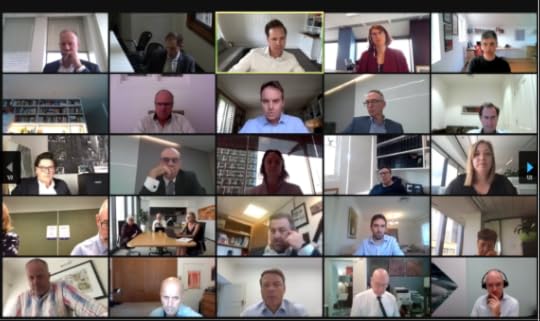
Our fourth roundtable on 3 March had a distinctly international flavour, with a presentation from Paul Bodnar, former Senior Director at the US National Security Council and Special Assistant to President Obama on international climate policy. Participants discussed recent developments abroad – such as the Biden Administration’s climate and recovery agenda. There were reflections on how tackling climate change is moving from being a project between nation-states (exemplified through formal negotiations at the UNFCCC) to being a mainstream project of the private sector (exemplified through initiatives like ‘We Are Still In’ in the United States).
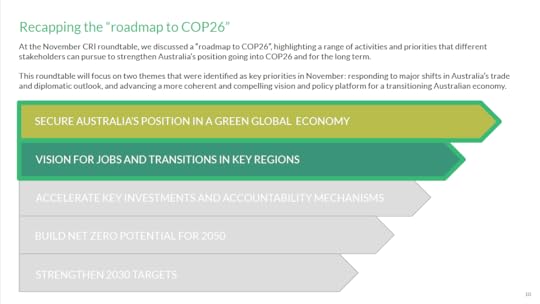
Participants also discussed jobs and transition planning in key regions domestically in Australia, including potential models for coordination and cooperation on economic transition. Here, the roundtable reflected on lessons from Germany’s coal transition commission, as well as the recently completed Just Transition Plan in Collie, WA. There were also updates on proposals from previous CRI discussions, including the potential for adding climate risk and resilience to the National Cabinet agenda, and the creation of a Co-Investment Partnership for clean technology market creation.
You can view more information about the event, including an agenda and participant list, by accessing the briefing pack below.
Fifth Roundtable — 9 June 2021
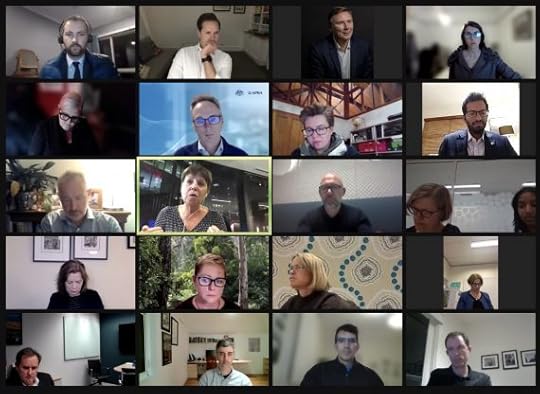
Taking place just days before the G7 summit in Cornwall, the fifth roundtable built on the previous meeting’s roadmap to COP26 by focussing on: strengthening targets in the long term (2050) and short term (2030), the global acceleration in climate investment and accountability, and asking what’s holding us (and the nation) back from reaching our potential for proactive decarbonisation.
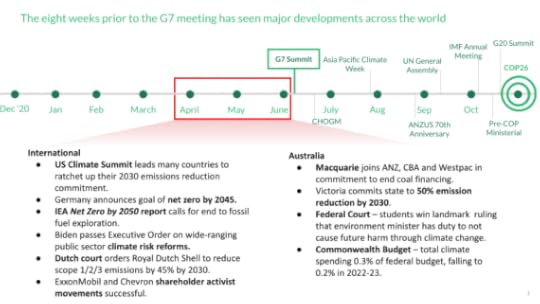
The roundtable incorporated both international and domestic perspectives on climate change policy. Christophe McGlade and Timothy Goodson from the International Energy Agency (IEA) presented findings from the IEA’s landmark report, released in May 2021, laying out a credible pathway to decarbonise global energy systems.
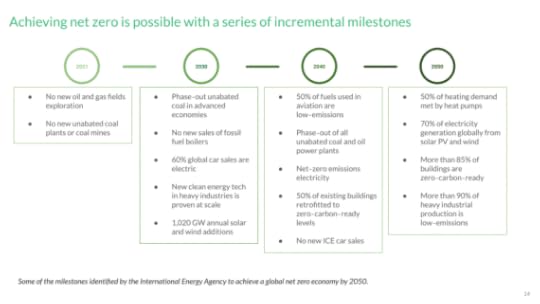
Professor Wing Woo from the UN Sustainable Development Solutions Network also provided an insightful international perspective on the role of the corporate sector in leading decarbonisation in South-East Asia. The roundtable then turned its attention to the G7 summit, discussing the work of G7 countries toward achieving net zero and Australia’s strategy in the lead up to COP26.
These opening remarks framed the following discussion, which had a more national focus. Participants highlighted progress in a range of sectors towards net zero targets, but also provided frank and insightful reflections on the work that still needs to be done.
The session concluded with a poll that turned the group’s attention to concrete policy priorities; big efforts that could help Australia achieve a net zero emissions economy that benefits all Australians. Coordination between parties – whether by acting collectively to set bolder 2030 goals, or by having states work on national policy harmonisation – were clear winners.
Further information on the roundtable, including an agenda, participants and discussion points is available in the briefing pack below. The CRI will continue to be active throughout 2021.
Key Documents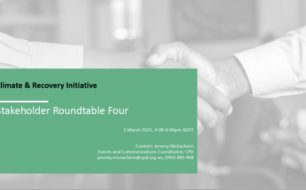
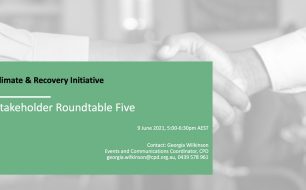
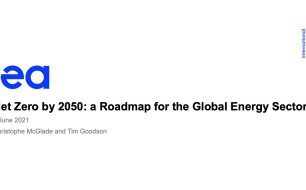 Roundtable Four Briefing Pack Roundtable Five Briefing Pack International Energy Agency Slides
Roundtable Four Briefing Pack Roundtable Five Briefing Pack International Energy Agency Slides Related Reading
G7 Summit Communique, 13 June 2021
2021 NSW Intergenerational Report and climate risk background paper
Net Zero by 2050, IEA report, May 2021
An All-In National Climate Strategy to Deliver Ambitious, Robust, and Credible U.S. Action, America’s Pledge, February 2021
Centre for Policy Development Discussion Paper: Chasing the Pack: Australia’s prospects on green trade and climate diplomacy, Toby Phillips, February 2021
Global climate action will reshape Australia’s trade, The Australian Financial Review, Toby Phillips, February 2021
New Analysis Shows the Global Transition from Coal to Clean Energy Has Reached a Financial Tipping Point, Rocky Mountain Institute, June 2020
The Growing Market for Clean Energy Portfolios & Prospects for Gas Pipelines in the Era of Clean Energy, Rocky Mountain Institute, 2019
The post Fourth and fifth Climate & Recovery Initiative stakeholder roundtables appeared first on Centre for Policy Development.
June 14, 2021
ASEAN leadership needed to address forced migration amid Myanmar crisis, COVID-19: ADFM
Published in The Jakarta Post on 11 June 2021.
A recently convened track-two diplomatic forum is calling on ASEAN leaders to tackle the issue of forced migration, just as civil unrest and the COVID-19 pandemic have exacerbated the cross-border problem and more refugees are ending up on Indonesian shores.
Southeast Asia continues to have “deficits of leadership and accountability” when it comes to providing an adequate response to the forced migration issue, which requires ASEAN leaders to prioritize migrants’ protection, said Travers McLeod, coconvenor of the Asia Dialogue on Forced Migration (ADMF).
The ADFM has issued a report outlining the challenges representing likely drivers of forced migration in the wider Indo-Pacific region, based on a forum meeting in May that looked into aspects such as instability in Myanmar and the COVID-19 pandemic’s impact on migration.
The report, published last Friday, said that “renewed political instability and civil conflicts are creating new waves of potential forced migrants”.
The assessment came amid new waves of Rohingya refugee arrivals in Aceh province on Indonesia’s northwestern coast this week and last week. Members of the persecuted minority have resorted to perilous sea journeys to escape refugee camps in Bangladesh.
Some 1 million Rohingya live in cramped camps in Bangladesh, where human traffickers run lucrative operations promising to find them sanctuary abroad, including in Indonesia. They fled Myanmar to escape a military crackdown against them four years ago, which United Nations investigators said amounted to genocide.
Such examples of forced migration are further complicated by fresh unrest in Myanmar and the border closures that come with the COVID-19 pandemic, the ADFM has found.
Myanmar has been in turmoil since the military overthrew the democratically elected government in February. Protests against the junta have been met with violent repression that has killed hundreds of people.
In late March, 4,000 civilians fled the border regions of Myanmar’s Karen state into neighboring Thailand in an attempt to escape the Myanmar army’s attacks, according to the Karen Women’s Organization.
McLeod, who is also the CEO of the Center for Policy Development, said that innocent lives were lost because ASEAN leaders were not doing enough to mitigate the potential disaster.
“A lack of political will to address known responsibility gaps and tension between national and regional interests – particularly where domestic issues have cross-border impacts – exacerbate the difficulty in responding to these gaps,” he told The Jakarta Post.
Since the military coup in Myanmar, ASEAN leaders have issued a five-point consensus to address the crisis. Among the salient points is the planned appointment of a special envoy to mediate a dialogue. However, the follow-up to the consensus has continued at a sluggish pace.
Indonesia’s representative to the ASEAN Intergovernmental Human Rights Commission (AICHR), Yuyun Wahyuningrum, told the Post on Tuesday that the five-point consensus aimed to establish talks with people affected by the coup, and the special envoy was needed to begin this process.
“A political crisis needs a political approach […] and such talks are time-consuming. The fact that there isn’t even a special envoy is alarming at this point. There needs to be a sense of urgency to address this issue – people are dying as we speak,” she said.
The Assistance Association for Political Prisoners, a rights group keeping track of deaths and arrests in Myanmar, reported 847 deaths last week instigated by the country’s security forces. The number is expected to continue rising.
The region has long seen gaps in its response to forced migration, but now it is exacerbated by the pandemic, increasing the risk of trafficking and the harassment of marginalized groups, according to the ADFM report.
Due to the pandemic, greater border securitization has reduced what little protection was offered to forced migrant populations, the forum found.
There are concerns authorities are pushing refugees back to their countries of origin because of the pandemic, despite continued opposition against the junta in the region.
There is no excuse to push people back to unsafe situations, said the Border Consortium, which is based in Bangkok. It added that authorities and relevant agencies should instead ensure adequate COVID-19 screening, quarantine and treatment facilities for those crossing the border.
At least 92,000 people from Myanmar’s border provinces are living in refugee camps in Thailand as a result of decades-long unrest in the area, according to the refugee support group.
The ADFM report stated that one possible solution to address forced migration is to utilize existing early warning systems and networks in the region.
“We need to fully use the mandates of existing entities to tackle the forced migration issue in the region, such as the Bali Process framework, ASEAN and AHA Center mandates,” McLeod said.
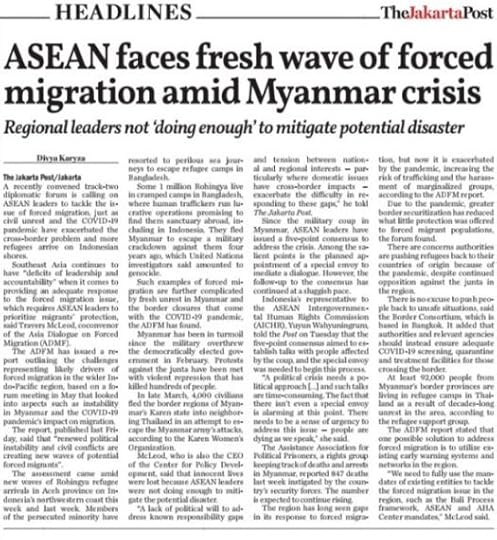
The post ASEAN leadership needed to address forced migration amid Myanmar crisis, COVID-19: ADFM appeared first on Centre for Policy Development.
June 3, 2021
Tenth meeting | ASIA DIALOGUE ON FORCED MIGRATION | May 2021
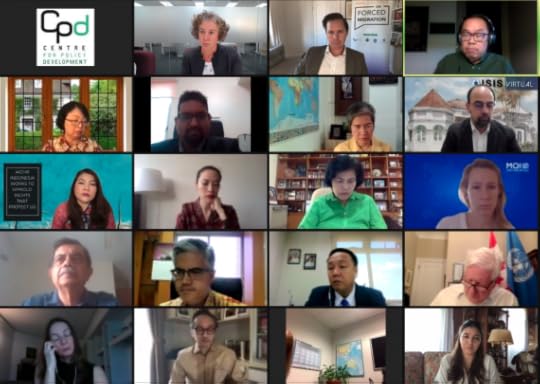
Key documents for the tenth ADFM meeting:
Full agenda and participant list Participant profiles Discussion Paper Co-Convenors’ StatementOn 6 May 2021 the Asia Dialogue on Forced Migration (ADFM) convened virtually for its tenth meeting. The meeting took place over two hours and involved participants based in eight countries, stretching from New Delhi to New York. All participants attend in a personal capacity and discussions take place under the Chatham House Rule. This virtual meeting followed the ADFM’s ninth meeting in Dhaka in February 2020, where the Secretariat also returned to Cox’s Bazar to follow up on the Trafficking risk assessment conducted there in 2018-19.
The meeting was held amid a deteriorating situation for forced migration in the Indo Pacific. The unfolding crisis in Myanmar, the continued displacement of the Rohingya in Bangladesh and stalemate in progress toward safe, dignified, voluntary repatriation, the COVID-19 pandemic, climate change, and threats to peace and stability in countries across the region combine to make sudden displacement more likely.
These challenges were outlined in a discussion paper prepared by the ADFM Secretariat ahead of the meeting. The purpose of the paper is to be an up to date resource to assist governments in the region in choosing where to concentrate their efforts. It has been updated based on feedback and input from ADFM participants and experts.
The first part of the meeting focused on specific events, particularly political instability in Myanmar and the ongoing stalemate on repatriation for those Rohingya displaced on the Bangladesh border. While those working closely with the issues described the situation in grave terms, there are clear practical things that can be done. This includes pursuing mini-lateral and bilateral arrangements with interested parties and champion countries, strengthening humanitarian responses, providing protections for irregular migrants in place, conducting strategic research to inform policy and engaging with local actors and those most affected.
The role of existing institutions and the need to make the most of their mandates was discussed in the second part of the discussion. The role of ASEAN, particularly the appointment of a Special Envoy and the role of the AHA Centre, were also identified as having the potential to make a big difference. The upcoming twentieth anniversary of the Bali Process and associated events, were also identified as an opportunity for reviewing and rejuvenating this institution, potentially through a strategic assessment of future priorities.
Despite the gravity of the situation, we were pleased to see broad consensus on the challenges ahead and energy around the need to act and scale of the challenges we are facing in the region. The ADFM Secretariat will continue to advance proposals in close consultation with key partners, and will likely meet next towards the end of 2021.
The post Tenth meeting | ASIA DIALOGUE ON FORCED MIGRATION | May 2021 appeared first on Centre for Policy Development.
May 20, 2021
Zoe Whitton on Q+A
Broadcast on Thursday 20 May 2021
CPD Board Member Zoe Whitton appeared on Q+A to discuss the government’s latest plans to build a gas-fired power plant and the long-term economic benefits of shifting to renewables.
“When you’re an investor, your number one stakeholder is reality.”
You can view the full episode below:
The post Zoe Whitton on Q+A appeared first on Centre for Policy Development.
May 19, 2021
Arjuna Dibley: Government-owned firms like Snowy Hydro can do better than building $600 million gas plants
Published in The Conversation on 20 May 2021.
The Morrison government today announced it’s building a new gas power plant in the Hunter Valley, committing up to A$600 million for the government-owned corporation Snowy Hydro to construct the project.
Critics argue the plant is inconsistent with the latest climate science. And a new report by the International Energy Agency has warned no new fossil fuel projects should be funded if we’re to avoid catastrophic climate change.
The move is also inconsistent with research showing government-owned companies can help drive clean energy innovation. Such companies are often branded as uncompetitive, stuck in the past and unable to innovate. But in fact, they’re sometimes better suited than private firms to take investment risks and test speculative technologies.
And if the investments are successful, taxpayers, the private sector and consumers share the benefits.
Lead, not limitFederal energy minister Angus Taylor announced the funding on Wednesday. He said the 660-megawatt open-cycle gas turbine at Kurri Kurri will “create jobs, keep energy prices low, keep the lights on and help reduce emissions”.
Experts insist the plan doesn’t stack up economically and may operate at less than 2% capacity.
But missing from the public debate is the question of how government-owned companies such as Snowy Hydro might be used to accelerate the clean energy transition.
Australian governments (of all persuasions) have not often used the companies they own to lead in clean energy innovation. Many, such as Hydro Tasmania, still rely on decades-old hydroelectric technologies. And others, such as Queensland’s Stanwell Corporation and Western Australia’s Synergy, rely heavily on older coal and gas assets.
Asking Snowy Hydro to build a gas-fired power plant is yet another example – but it needn’t be this way.
The burning questionGlobally, more than 60% of electricity comes from wholly or partially state-owned companies. In Australia, despite the 20-year trend towards electricity privatisation, government-owned companies remain important power generators.
At the Commonwealth level, Snowy Hydro provides around 20% of capacity to New South Wales and Victoria. And most electricity in Queensland, Tasmania and Western Australia is generated by state government-owned businesses.
But political considerations mean government-owned electricity companies can struggle to navigate the clean energy path.
For example in April this year, the chief executive of Stanwell Corporation, Richard Van Breda, suggested the firm would mothball its coal-powered generators before the end of their technical life, because cheap renewables were driving down power prices.
Queensland’s Labor government was reportedly unhappy with the announcement, fearing voter backlash in coal regions. Breda has since stepped down and Stanwell is reportedly backtracking on its transition plans.
Such examples beg the question: can government-owned companies ever innovate on clean energy? A growing literature in economics, as well as several real-world examples, suggest that under the right conditions, the answer is yes.
Privatised is not always bestEconomists have traditionally argued state-owned companies are not good innovators. As the argument goes, the absence of competitive market forces makes them less efficient than their private sector peers.
But recent research by academics and international policy institutions such as the OECD has shown government ownership in the electricity sector can be an asset, not a curse, for achieving technological change.
The reason runs contrary to orthodox economic thinking. While competition can lead to firm efficiency, some economists argue government-owned firms can take greater risks. Without the pressure for market-rate returns to shareholders, government enterprises may be freer to invest in more speculative technologies.
My ongoing research has shown the reality is even more complex. Whether state-owned electric companies can drive clean energy innovation depends a great deal on government interests and corporate governance rules.
For example, consider the New York Power Authority (NYPA) which, like Snowy Hydro, is wholly government owned.
New York Governor Andrew Cuomo has deliberately sought to use NYPA to decarbonise the state’s electricity grid. The government has managed the company in a way that enables it to take risks on new transmission and generation technologies that investor-owned peers cannot.
For instance, NYPA is investing in advanced sensors and computing systems so it can better manage distributed energy sources such as solar and wind. The technology will also simulate major catastrophic events, including those likely to ensue from climate change.
These investments are likely to contribute to greater grid stability and greater renewables use, benefiting not just NYPA but other electricity generators and ultimately, consumers.
Such innovation is nothing new. Also in the US, the state-owned Sacramento Municipal Utility District built one of the first utility-scale solar projects in the world in 1984.
The way forwardMore could be done to ensure Australian government-owned corporations are clean energy catalysts.
Clean energy technologies can struggle to bridge the gap from invention to widespread adoption. Public investment can bring down the price of such technologies or demonstrate their efficacy.
In this regard, government-owned companies could work with private technology firms to invest in technologies in the early stages of development, and which could have significant public benefits. For instance, in 2020, the Western Australian government-owned company Synergy sought to build a 100 megawatt battery with private sector partners.
But many problems facing state-owned companies are the result of ever-changing government policy priorities. The firms should be reformed so they are owned by government, but operated at arm’s length and with other partners. This might better enable clean energy investment without the politics.
The post Arjuna Dibley: Government-owned firms like Snowy Hydro can do better than building $600 million gas plants appeared first on Centre for Policy Development.
May 12, 2021
Sam Mostyn: An encouraging step in a long journey for women
Published in The Sydney Morning Herald, 13 May 2021
This week’s budget was an encouraging step towards rebalancing the national focus on increasing women’s workforce participation and economic security, and renewing commitments to women’s safety.
A range of measures – including making childcare more affordable, the removal of the minimum threshold on superannuation, investment in the aged care sector and the funding of commitments to address domestic and family violence, sexual assault and sexual harassment in workplaces – will certainly make a difference for many women.
With the foundation now laid, it’s appropriate to contemplate what might be achieved with an even greater collective, focused effort, and an understanding that investments in the scaffolding of women’s economic participation are some of the smartest ways to strengthen Australia’s COVID recovery. In effect, these too are infrastructure investments.
The $3.4 billion worth of measures outlined in the Women’s Budget Statement reflect a growing recognition that previous recovery and structural economic investments have not addressed the fundamental gender imbalance in the way benefits flow to the community.
The statement, however, should not be confused with gender-responsive budgeting, which Chief Executive Women and many others called for in this budget. As a result, we know through the statement that the specific measures for women represent less than 1 per cent of the overall budget spend of approximately $670 billion.No great change can happen and no major obstacle can be overcome without focus.We saw what happened when all sides of politics, the private, public and not-for-profit sectors, unions and other organisations worked together on our national response to COVID. Through this unprecedented co-operation, that collective force was able to steer the country through the most challenging circumstances – all by having a very clear and targeted focus.
Women in leadership should be included at the table where this work is done.
As we call for an even greater focus on increasing workforce participation and economic security for women, it’s worth reflecting on the example of workplace health, safety and wellbeing which was not truly recognised as a priority until the mid-1980s when laws were first introduced to address workplace safety.
That effort has saved lives and workplace injury fatality rates have reduced by 48 per cent since 2007. It has also improved productivity and profitability for businesses right across Australia. An initiative that was initially considered a “nice to have”, it is now an essential part of any business, to benefit individual employees and because it makes good business sense. It is now simply part of the entrenched “business-as-usual” operations of running a business.
Ultimately, we want the same business-as-usual approach across all decision-making when it comes to the consideration of women, particularly to enable them to participate or increase their participation in the workforce.
Women are ready to drive our future economy prosperity. This will happen by having a very focused collective effort to invest in industries that are dominated by women, something we consider is a missed opportunity in the federal budget.
How do we invest in those industries that are dominated by women, particularly when we consider for every $1 million spent on education creates 10.6 direct jobs for women and 4.3 direct jobs for men, compared to 0.2 jobs for women and 1 job for men in construction?
How do we improve our paid parental leave scheme to ensure it enables both parents to access care for young children?
How do we ensure even more funding can be secured to help address family and domestic violence and sexual assault services?
How do we ensure women can progress in their careers at the same pace, with the same opportunities and wages as their male colleagues, while balancing family and caring commitments?
How can we support women who are unemployed or underemployed get back into the workforce? How do we ensure even more families benefit from childcare savings sooner?
How do we ensure that all decisions are reviewed with the consideration of gender to understand whether there are elements of policy that may have unintended consequences for women? How do we reduce the disparity in superannuation between men and women when they head into retirement?Ultimately, how do we stop Australia’s continued slide down the rankings in the World Economic Forum’s gender gap, which saw Australia fall from 12th position in 2006 to 70th position this year on the measure of women’s economic participation?
It’s clear that working collectively, as part of a mission with a very clear focus is the answer.
This is not simply ‘nice to have’ – we are talking about improving Australia’s economy by unlocking potential of women across the country. KPMG modelling shows that halving the gap between male and female workforce participation rates would increase Australia’s annual GDP by $60 billion over 20 years. So clearly, there should be no question about whether unlocking this potential is a smart thing to do.
At Chief Executive Women – with a membership base that is responsible for leadership roles in more than 100 of Australia’s largest public and private organisations, overseeing revenues of $368 billion and more than 1.4 million employees – we stand ready to play a part in this collective effort.The budget measures announced are a good first step, and we look forward to working with the government, the Women’s Cabinet Taskforce and the National Cabinet to drive more ambitious and broad reaching reform to unleash the potential for more women to contribute to our economic recovery.
The time has come to maximise the potential of all Australians and build our economy back stronger and smarter.
The post Sam Mostyn: An encouraging step in a long journey for women appeared first on Centre for Policy Development.
May 10, 2021
Introducing CPD’s Early Childhood Development Initiative
CPD’s Early Childhood Development (ECD) Initiative aims to elevate children on the national policy agenda by developing a vision for an integrated ECD system that will deliver benefits for children, families and communities, particularly those facing disadvantage.
Australia has made great progress in many aspects of early childhood policy reform. Examples of this include:
Improving the quality and consistency of early childhood education and care services.Helping families to balance work and child rearing.Improvements in meeting the needs of First Nations children and families including connection to culture.Providing a minimum entitlement to paid parental leave.Delivering quality maternal and child health services to the vast majority of Australian families.These achievements have been delivered by all levels of government, at federal, state and territory level, including in partnership with innovative non-government organisations.
Yet unfinished business remains. Despite all Governments investing in new early childhood policies and programs, too many children are still missing out, and it is often those who stand to benefit most from quality ECD services. More than one in five children are developmentally vulnerable when they start school, disproportionately from lower-income families. Getting it right for all children and families will require national collaboration, commitment, and policy innovation, not just business as usual.
The ECD initiative works with policy-makers, early childhood sector leaders and experts to create space for new, collaborative policy thinking and action. The Initiative comprises two parts:
The ECD Council brings together policy-makers and experts to engage with evidence, develop policy options, and share ideas. The Council is co-chaired by CPD Fellow Leslie Loble and Jay Weatherill (CEO, Thrive by Five).The Scoping Study translates new and existing evidence into resources and models to inform better policy decisions.Over three years, the ECD Council and Scoping Study will strengthen the connections between the ECD policy process, and evidence from practice and research.

The Scoping Study has five interconnected focus areas that are key for ECD system reform: system design, investment, workforce, place-based approaches, and data. These focus areas were identified after the first meeting of the ECD Council in October 2020, based on a review of existing evidence of how best to realise the vision of integrated ECD systems to support child development.
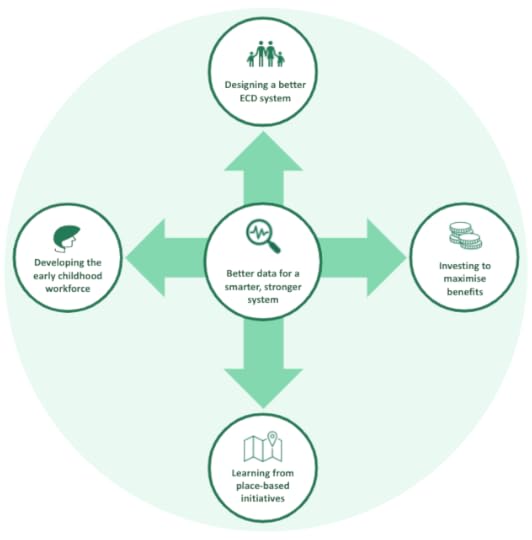
The ECD Initiative is led by Program Director Jen Jackson and Policy Advisors Caitlin McCaffrie and Frances Kitt. It is supported by an expert Steering Group, and works collaboratively with other major national ECD initiatives. It has been made possible by the generous support of the Minderoo and Ian Potter Foundations.
To receive updates on the ECD Initiative and other CPD work, please subscribe to our monthly eNews and follow us on Twitter (@CentrePolicyDev). See our contacts page for media inquiries.
Links and Related Reading:
Effective Government ProgramJen Jackson, Early childhood educators are leaving in droves. Here are 3 ways to keep them, and attract more, The Conversation, January 2021Travers McLeod & Sam Mostyn, Australia needs to find its heart, brain and courage to recover from the COVID nightmare, The Guardian, October 2020Travers McLeod & Sam Mostyn, Coronavirus is a human crisis beyond most of our scariest dreams – we will need to restart our society, The Guardian, April 2020The post Introducing CPD’s Early Childhood Development Initiative appeared first on Centre for Policy Development.
May 5, 2021
Tim Nelson: Australia’s states are forging ahead with ambitious emissions reductions. Imagine if they worked together
Published in The Conversation, 06 May 2021.
In a recent article for The Conversation, our Research Committee Member Tim Nelson analysed how Australia’s states can better work together to reach ambitious new emissions targets.
He wrote: “To date, the states have not announced any new plans for a coordinated national approach to emissions reductions. But as their respective plans and commitments gather pace, a state-led national policy makes perfect sense – and it could be achieved without the need to reach agreement with the federal government.”
You can read the full article here.
The post Tim Nelson: Australia’s states are forging ahead with ambitious emissions reductions. Imagine if they worked together appeared first on Centre for Policy Development.
May 2, 2021
Sam Mostyn: Investing in women will pay dividends for the whole economy
Published in The Age, 30 April 2021
Watching the fourth – and best – AFL women’s grand final two weeks ago, I felt a penny drop.
Sun beamed on a legion of game-changer footballers in Adelaide, and I was struck by what felt like a perfect analogy: translating the story of seeking equality for women in the upcoming federal budget.
A career kicking goals under a floodlit MCG was never for me. Frankly, it was not an option. I am a woman, so the opportunity did not exist.
Women had been playing organised football for more than 100 years before the AFL launched the women’s league we know today as AFLW.
When the first AFLW match was played on February 3, 2017, the ground shook. AFL commentator Samantha Lane described it in her book ROAR: “Here, suddenly, was the AFL’s single most profound act of inclusion in a 121-year history … In this watershed moment, big brother AFL did not merely acknowledge the existence of an ostracised relative, he validated it.”Today, young women growing up across Australia can pursue professional football careers. They can see themselves on the field: powerful, proud and capable of anything.
Ask many men about what AFLW has brought to the game, and most will describe it as the smartest innovation of the past century. Many of the seasoned commentators marvel at how unimaginable footy would be without AFLW. Others reflect on the missed opportunities of not starting many years earlier.
I was the first woman to join the AFL Commission, and alongside our then chairman Mike Fitzpatrick, fellow commissioners and executives, was among the proud cohort to oversee the birth of AFLW.
I think back to the vision and guts of those who made the decision to invest seriously in a women’s league. I think about the pioneering clubs that sought licences. I think about visionary people who battled the doubters – indeed the denigrators – and the risk-averse. And I think about the pioneering women players who had to wait decades for this respect, and inclusion.
Investing meaningfully in women and girls as footballers has improved, enriched and enlivened the institution of the AFL. The sheer reach of the game has never been so broad, and the fervency of fans has never been more intense.
We stand at a similar moment for the economic inclusion and safety of women in Australian life.
Just as unusual allies came together to call for a women’s league – a case that was grounded in calls for respect, inclusion, and allowing potential to shine – this week the Business Council of Australia, the Australian Council of Trade Unions, Chief Executive Women, The ParentHood, GoodStart Early Learning and women’s rights advocate Wendy McCarthy, stood together in support of respect for Australian women in this year’s budget.
This budget presents an extraordinary opportunity to make smart investments that remove structural barriers for women who wish to fully participate in the paid workforce and to unlock greater productivity in the Australian economy.
The opportunities are immense. Put simply, Australia’s immediate economic recovery and future prosperity relies on women being appropriately represented in the workforce.Last month’s Global Gender Gap Report, from the World Economic Forum, showed Australia had fallen to 50th in the world for overall gender gap, and 70th in relation to women’s economic participation, down from 12th in 2006. Yet economic modelling by KPMG shows increasing women’s workforce participation by just 5 per cent would boost Australia’s real GDP by $20 billion over five years.Today, millions of Australian women face economic, social and legislative hurdles that prevent them from reaching their goals and, in the process, making Australia stronger.
What does a budget focused on women to drive the economy look like?
It removes the structural barriers to women’s full participation in the workforce – particularly by investing in childcare and paid parental leave – and reduces the precarious underemployment of women.Just as successive governments have done for other sectors such as construction, building and energy, a budget focusing on women would invest in industries that are dominated by women.The government must ensure Australia’s emergence from the pandemic does not further entrench the inherent disadvantage of women by focusing on the jobs that are traditionally held by men.
Chief Executive Women is advocating to enable women’s workforce participation by investing and reforming access to early childhood education by removing disincentives for secondary earners (including men) like the “per child″ cap. There is an opportunity to consider childcare investment as a big, bold investment to empower Australia’s entire talent pool now and in the future.
Australian women are among the smartest and most educated in the world. We need to unlock the potential of these women, particularly now at a time of low immigration and as we rebuild our economy after the COVID-19 pandemic.
The underemployment of women was an issue before the shocks of the pandemic reverberated globally, and we need to be conscious that this doesn’t become further entrenched without policies that support quality full-time work for women.At Chief Executive Women, we believe women must have a seat at the table where the decisions are made. A small step in this direction is reinstating the Women’s Budget Statement, using input from the women’s sector.
We also wholeheartedly support calls for new and adequate funding for domestic, family and sexual violence services, as well as funding for improved prevention of gendered violence.
The greatest risk to the Australian economy and women’s economic inequality is budgetary half measures.
Doing the bare minimum is akin to giving women an AFL ball but making them play a scratch match without light, boots or jumpers.
This cannot be the story of the upcoming federal budget.Given the debate we have been through in recent months about the need for more respect for women across society, this is the opportunity for profound action from the government.
In recent months, Attorney-General Michaelia Cash and Prime Minister Scott Morrison have foreshadowed that extra funding will be allocated to help equalise the participation of women through the budget. Minister for Women Marise Payne has said: “With our recovery, we have an opportunity to build a more flexible, equal economy that includes everyone’s contributions. Given the task ahead, frankly, we can’t afford to not include everyone.“
Rhetoric must be followed by action, investment, funding, legislative change, and engagement with the women’s sector. Otherwise, the symbolic strides recently made will have been for little.
A single budget focused on women is not the answer to the structural inequality that women face, just as the AFLW requires more funding and higher salaries for its players. But it can be the start of a much larger shift for women in Australia.Instead of waiting five or 10 or 20 more years, we can begin to rebalance the scales now. We can give women an opportunity that their mothers, aunts and grandmothers never had.
One-eyed, I’m barracking hard.
The post Sam Mostyn: Investing in women will pay dividends for the whole economy appeared first on Centre for Policy Development.
April 26, 2021
Companies warned that ‘greenwashing’ could have legal consequences
Published by RenewEconomy on Monday 26 April 2021.
Company directors that rush to make net zero pledges without fully examining the firm’s ability to meet the goals could be guilty of “misleading or deceptive conduct” and vulnerable to regulatory or legal penalties.
They also have a legal obligation to act on climate risk, not just to disclose it, or face accusations of “greenwashing” that could carry real legal consequences.
Those are the opinions of lawyers Noel Hutley SC and Sebastian Hartford Davis, published in an official update to their landmark 2016 legal opinion entitled “Climate Change and Directors’ Duties”, commonly known as the Hutley opinion.
The update followed a business and regulatory roundtable on climate risk hosted by the Centre for Policy Development, and attended by major business groups including the Business Council of Australia, the Australian Institute of Company Directors and the Australian Chamber of Commerce and Industry.
Following the meeting, the CPD commissioned Hutley and Hartford Davis to update their opinion.
“It is clear the benchmark for directors on climate change and attendant risks and opportunities continues to rise,” the updated opinion reads.
“Firms and sectors with significant exposures to a decarbonising global economy are facing pressure from their shareholders and stakeholders to consider net zero strategies and commitments of this nature. The COVID-19 pandemic has elevated a focus on how firms and sectors prepare and act in respect of other foreseeable systemic risks like climate change.
“In our opinion, it is no longer safe to assume that directors adequately discharge their duties simply by considering and disclosing climate-related trends and risks; in relevant sectors, directors of listed companies must also take reasonable steps to see that positive action is being taken: to identify and manage risks, to design and implement strategies, to select and use appropriate standards, to make accurate assessments and disclosures, and to deliver on their company’s public commitments and targets.”
In the last year, there has been a rush of companies announcing climate-related pledges, many of which include net zero pledges generally by 2050. Hutley and Harford Davis said there was a risk that many of these are being made without reasonable basis, and could “therefore be taken to have misled or deceived, or to be likely to mislead or deceive, the users of those financial statements”.
That would expose them to penalties from the Australian Securities and Investment Commission (ASIC).
It’s a stark warning to companies that have made their pledges without much thought, in a false sense of ease over the long timeframe and current lack of clear regulatory or legal approach to climate risk. This is a wake-up call for such businesses, reminding them that net zero pledges are serious statements of corporate intent and must not be made unless work has been done to ensure they are deliverable.
“The duty of care for directors on climate risks is now clear,” said Travers McLeod, chief executive of the CPD.
“The conversation has shifted emphatically to the rising standard of care directors are required to discharge with respect to climate change. The focus is now on the gap between what needs to happen, or what is being promised, and what is being done.
“Many Australian firms have been stepping up their climate-related governance, disclosure and capabilities to meet this head on. But it is clear more is needed to keep pace, as surging momentum on net zero reshapes global markets and regulators, shareholders, customers and policy makers step up their scrutiny of corporate responses.”
The opinion comes days after the Australian Prudential Regulation Authority published draft guidance instructing financial service providers that they must respond to the physical, transitional and litigation risks being created by climate change.
The post Companies warned that ‘greenwashing’ could have legal consequences appeared first on Centre for Policy Development.
Centre for Policy Development's Blog
- Centre for Policy Development's profile
- 1 follower




